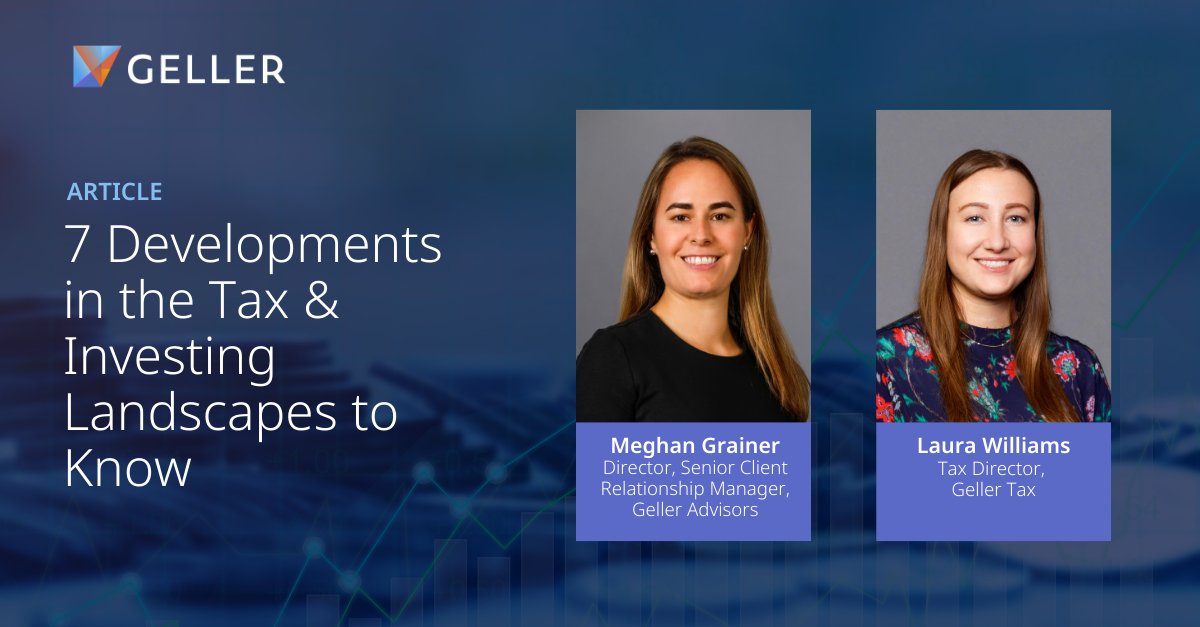Many investors have begun to turn their attention to what the rest of this year may bring, i.e., what key themes are important to be aware moving forward? Here we outline seven major developments in the world of investments and tax planning investors need to know.

1. FED, ECONOMY, INFLATION ALL IN FOCUS. AND T-BILLS’ TIME TO SHINE
“Don’t fight the Fed” is a well-worn mantra, such is the hold the central bank has on financial markets. All eyes are currently on their next moves regarding the direction of interest rates. Given the decidedly mixed macroeconomic backdrop, policymakers have much to ponder.
The long-predicted recession has thus far failed to materialize. That said, July’s jobless rate of 4.3% — although still indicative of essentially full employment – was nonetheless materially higher than the 53-year-low of 3.4% set in spring 2023. And inflation, even as it has cooled considerably from its four decade peak of 9.1% set in June 2022, is proving stubbornly sticky and remains above the Fed’s stated 2% target.
The number of rate cuts analysts expect this year, which stood as high as six at the outset of 2024, has been substantially scaled back. The Federal Open Market Committee (FOMC) has as yet opted against any cuts, leaving rates unchanged at a 23-year high at their most recent meeting. We believe that upcoming FOMC policy will be heavily data dependent, and that a rate reduction is almost certain before the end of the year.
Fortunately, the current interest rate environment carries certain advantages for more risk-averse investors. We are continuing to see dry powder post-pandemic cash, previously sitting on the sidelines, be deployed in money market funds and Treasury Bills. Both are seen as relative safe-haven plays and, with each offering enticing yields of approximately 5%, provide attractive real return potential after inflation.
According to recent figures from the Investment Company Institute, money market funds now hold a record $6.12 trillion in assets. T-bills, meanwhile, are exempt from state and local taxes. Regarding T-bill investment allocation, when the Fed does eventually begin cutting rates our view is that investors can benefit from going further out on the yield curve by buying longer duration fixed income instruments.
2. MAGNIFICENT SEVEN NOW A FAB FOUR
It’s been a tale of two markets, with bifurcation in evidence as a handful of select mega-cap tech names considerably outperform broader benchmarks. The so-called ‘Magnificent Seven’ stocks (Google parent Alphabet, Amazon.com, Apple, Facebook parent Meta Platforms, Microsoft, Nvidia, and Tesla) attracted waves of initial investor interest. This helped propel the S&P 500’s gains to such a disproportionate extent that the S&P 500’s performance actually drops by half when the index is instead measured on an equal-weighted basis. (That is to say, when each individual equity in the index is assigned identical importance, irrespective of size or stock price.)
Subsequently, relative underperformance from Alphabet, Apple, and Tesla has fanned talk of a narrower ‘Fab Four.’ And within this subset, semiconductor stock Nvidia—powered by the inexorable rise of Artificial Intelligence—has been first among equals. In a cautionary note, however, the ‘Fab Four’ have entered correction territory since June.
Investors of a certain age may recall other eras of extreme market concentration, such as the ‘Nifty Fifty’ domination of the early 1970s or the Dotcom bubble during the late 1990s. History—and Geller’s Investment Management team—indicates that during such times, certain fundamental rules apply. When valuations become stretched and stocks stand at historic highs, it is especially important to work in tandem with experienced wealth advisors. The major takeaway? We believe holding a diversified basket of assets (including looking at alternative investment strategies), avoiding trying to time the market, and practicing disciplined dollar cost averaging can all confer an advantage.

3. USE IT OR LOSE IT: DRASTIC DROP LOOMS IN GIFT & ESTATE TAX EXEMPTION
Elections have consequences, arguably nowhere more so than in the realm of tax policy. Ronald Reagan’s landslide reelection victory, for instance, ushered in the landmark tax reform legislation of 1986. That remained the single largest overhaul of the nation’s tax code until Donald Trump took office in 2017. The Tax Cuts and Jobs Act (TCJA), signed the same year, included several important provisions which especially impact ultra-high-net-worth individuals (UHNWIs). Absent the unlikely event of the White House, Senate, and House all acting in unison, several of these measures are scheduled to sunset at the stroke of midnight on December 31, 2025.
As a recent report by Bloomberg Intelligence points out, a solid Trump victory does enhance the prospect that some provisions of the TCJA could be codified rather than allowed to expire. The odds on such a scenario did shorten immediately following the first presidential debate. That said, the landscape can certainly shift between now and Election Day. Accordingly, investors should prepare for multiple possible permutations and every eventuality.
The clock is already ticking here, with the lifetime estate and gift tax exemption threshold particularly relevant to UHNWIs. The current exemption amount of $13.61 million is set to be cut roughly in half, adjusted for inflation.
That may seem like a long way away, but given the sheer complexity of the issues involved and the demands that estate planning attorneys will face as the deadline approaches, wealthy individuals (and business owners looking to exit especially, with regard to this estate tax exemption sunset) would do well to get ahead of the inevitable last minute rush.
Ultimately, investors wishing to take advantage of the lifetime exemption should be proactively working with their advisors now on identifying which assets would be most appropriate for gifting.
4. A NO ‘SALT’ DIET: STATE AND LOCAL TAX DEDUCTION SCHEDULED TO SUNSET
Under the TCJA, starting in 2018 taxpayers were limited to a $10,000 deduction for state and local taxes (SALT) paid. This had the effect of considerably curtailing itemized deductions. Annual real estate taxes and state income taxes were previously fully deductible, which greatly reduced taxable income. This was especially advantageous for residents of high tax states such as New York and California. The SALT limitation, however, is another provision that is set to lapse after 2025.
Where eligible, certain taxpayers opted to make pass-through entity tax (PTET) elections, a SALT deduction ‘workaround’ of sorts. This allowed pass-through entities such as limited liability companies to pay the state taxes on behalf of the partners, thus bypassing the $10,000 cap.
Since we are now under two years away from potential SALT expiration, for many it may not make sense to change their tax structure simply in order to qualify. Each scenario is highly situation-specific though, and any potential benefits depend upon the individual’s unique financial circumstances. As PTET is an annual election, Geller’s tax advisors are available to work with you to help determine the most tax efficient course of action.
5. BRACKET BUSTERS: EXPECT TAX RATES TO RISE IN 2026
As currently stands, the top individual and trust income tax bracket is set to increase from 37% to the 39.6% rate which was in effect prior to the passage of the TCJA.
Although this has attracted less attention than the estate tax, it does have the potential to exert a material impact on investment decisions. Specifically, where possible it may make sense to accelerate ordinary income before the rate increase or delay ordinary losses until 2026.
Additionally, while working with your wealth advisor on a strategy for tax loss harvesting, there may be a benefit to holding these losses for future years. When income thresholds for capital gains taxes readjust, this will result in a higher marginal tax rate in 2026. As such, pushing out any losses beyond 2024 and 2025 may be advantageous.
6. SWEET CHARITY: HOW TO STRETCH YOUR DONATION DOLLARS
At present, annual cash donations to public charities are deductible up to 60% of a taxpayer’s adjusted gross income (AGI). This TCJA threshold is scheduled to expire at the end of 2025, and revert back to the prior 50% limit. Taxpayers open to maximizing their annual charitable contributions should take advantage of the 60% limit available in 2024 and 2025.
7. This too shall pass? Potential QBI Deduction Sunset Looms large for pass-through businesses
The TCJA allowed owners of certain small businesses structured as pass-through entities to deduct up to 20% of their qualified business income (QBI). Examples of such qualified businesses include limited liability companies, partnerships, and self-employed individuals involved in a trade or business.
Unless bipartisan action is taken, this provision is also set to expire at the start of 2026. Its elimination will result in a much larger marginal income tax rate for those that previously qualified.
It may make sense for impacted business owners who currently benefit from the deduction to consider potentially accelerating income forward to 2024 and 2025.
In Conclusion
“The trend is your friend.” So goes one time-tested piece of Wall Street wisdom. By being aware of these seven key trends and developments, investors can prepare to prosper even amid uncertainty. Our team of specialists are happy to help.
